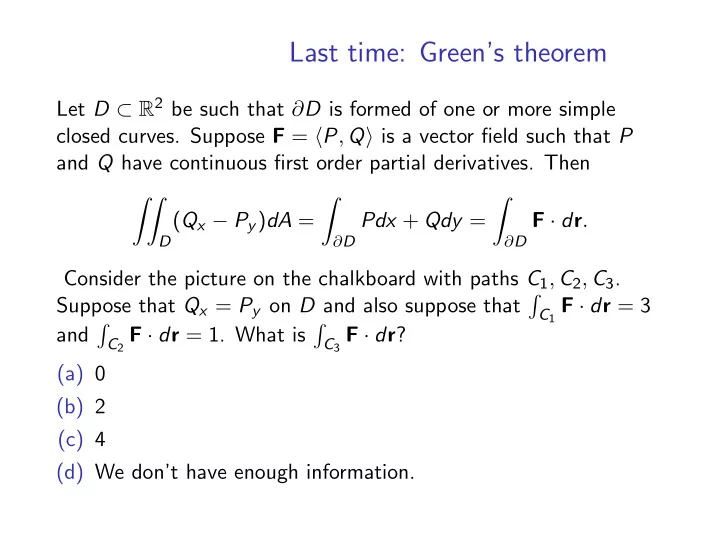

Last time: Green’s theorem Let D ⊂ R 2 be such that ∂ D is formed of one or more simple closed curves. Suppose F = ⟨ P , Q ⟩ is a vector field such that P and Q have continuous first order partial derivatives. Then ∫︂∫︂ ∫︂ ∫︂ ( Q x − P y ) dA = Pdx + Qdy = F · d r . D ∂ D ∂ D Consider the picture on the chalkboard with paths C 1 , C 2 , C 3 . ∫︁ Suppose that Q x = P y on D and also suppose that C 1 F · d r = 3 and ∫︁ C 2 F · d r = 1. What is ∫︁ C 3 F · d r ? (a) 0 (b) 2 (c) 4 (d) We don’t have enough information.
Practice with curl Find curl ⟨ e x , z cos y , sin y ⟩ . How many of the three components are 0? (a) 0 (b) 1 (c) 2 (d) 3 (e) I don’t know. curl ⟨ e x , z cos y , sin y ⟩ = ⟨ cos y − cos y , 0 − 0 , 0 − 0 ⟩ = ⟨ 0 , 0 , 0 ⟩
Practice with curl Find curl ⟨ P ( x , y ) , Q ( x , y ) , 0 ⟩ . Solution curl ⟨ P ( x , y ) , Q ( x , y ) , 0 ⟩ = ⟨ ∂ 0 ∂ y − ∂ Q ∂ z , ∂ P ∂ z − ∂ 0 ∂ x , ∂ Q ∂ x − ∂ P ∂ y ⟩ = ⟨ 0 , 0 , Q x − P y ⟩ .
Practice with conservative vector fields and curl Is F ( x , y , z ) = ⟨ xz , xyz , − y 2 ⟩ conservative? Is G ( x , y , z ) = ⟨ e x , z cos y , sin y ⟩ conservative? (a) Yes and yes. (b) Yes and no. (c) No and yes. (d) No and no. (e) Not enough information.
Recommend
More recommend